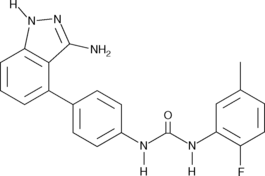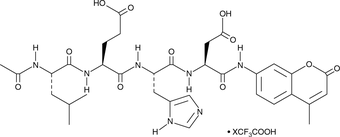Chemicals
Showing 7951–8100 of 41137 results
-
ABT-639 is a T-type calcium channel blocker.{48606} It inhibits inactivated-state Cav3.2 channels with an IC50 value of 2.3 μM and inactivated-state Cav3.1 and Cav3.3 channels by 50 and 39%, respectively, when used at a concentration of 10 μM. ABT-639 selectively inhibits inactivated-state T-type calcium currents over resting-state currents in rat dorsal root ganglion (DRG) neurons (IC50s = 7.6 and >30 μM, respectively). It reverses the hind limb grip force deficit in a rat model of osteoarthritic pain induced by monoiodoacetic acid (MIA; ED50 = 2 mg/kg). ABT-639 also increases the paw withdrawal threshold in rat spinal nerve ligation (SNL) and chronic constriction injury (CCI) models of neuropathic pain in a dose-dependent manner and attenuates cold allodynia in the CCI rat model when administered at doses greater than or equal to 3 mg/kg.
Brand:CaymanSKU:28742 - 10 mgAvailable on backorder
ABT-639 is a T-type calcium channel blocker.{48606} It inhibits inactivated-state Cav3.2 channels with an IC50 value of 2.3 μM and inactivated-state Cav3.1 and Cav3.3 channels by 50 and 39%, respectively, when used at a concentration of 10 μM. ABT-639 selectively inhibits inactivated-state T-type calcium currents over resting-state currents in rat dorsal root ganglion (DRG) neurons (IC50s = 7.6 and >30 μM, respectively). It reverses the hind limb grip force deficit in a rat model of osteoarthritic pain induced by monoiodoacetic acid (MIA; ED50 = 2 mg/kg). ABT-639 also increases the paw withdrawal threshold in rat spinal nerve ligation (SNL) and chronic constriction injury (CCI) models of neuropathic pain in a dose-dependent manner and attenuates cold allodynia in the CCI rat model when administered at doses greater than or equal to 3 mg/kg.
Brand:CaymanSKU:28742 - 25 mgAvailable on backorder
ABT-639 is a T-type calcium channel blocker.{48606} It inhibits inactivated-state Cav3.2 channels with an IC50 value of 2.3 μM and inactivated-state Cav3.1 and Cav3.3 channels by 50 and 39%, respectively, when used at a concentration of 10 μM. ABT-639 selectively inhibits inactivated-state T-type calcium currents over resting-state currents in rat dorsal root ganglion (DRG) neurons (IC50s = 7.6 and >30 μM, respectively). It reverses the hind limb grip force deficit in a rat model of osteoarthritic pain induced by monoiodoacetic acid (MIA; ED50 = 2 mg/kg). ABT-639 also increases the paw withdrawal threshold in rat spinal nerve ligation (SNL) and chronic constriction injury (CCI) models of neuropathic pain in a dose-dependent manner and attenuates cold allodynia in the CCI rat model when administered at doses greater than or equal to 3 mg/kg.
Brand:CaymanSKU:28742 - 5 mgAvailable on backorder
ABT-724 is a dopamine D4 receptor agonist with an EC50 value of 12.4 nM in a FLIPR calcium flux assay using HEK293 cells expressing the human D4.4 receptor and Gαqo5.{45687} It is selective for dopamine D4 over D2 receptors at 10 μM. ABT-724 (0.03 μmol/kg) induces penile erections in 77% of male rats. It decreases mounting frequency and ejaculation latency and increases ejaculation frequency and copulatory efficacy in male rats when administered at a dose of 0.04 mg/kg.{45688} ABT-724 (0.16 and 0.64 mg/kg) decreases hyperactivity and exploratory behavior in the open field test in an adolescent spontaneously hypertensive rat (SHR) model of attention-deficit hyperactivity disorder (ADHD).{45689}
Brand:CaymanSKU:29506 - 10 mgAvailable on backorder
ABT-724 is a dopamine D4 receptor agonist with an EC50 value of 12.4 nM in a FLIPR calcium flux assay using HEK293 cells expressing the human D4.4 receptor and Gαqo5.{45687} It is selective for dopamine D4 over D2 receptors at 10 μM. ABT-724 (0.03 μmol/kg) induces penile erections in 77% of male rats. It decreases mounting frequency and ejaculation latency and increases ejaculation frequency and copulatory efficacy in male rats when administered at a dose of 0.04 mg/kg.{45688} ABT-724 (0.16 and 0.64 mg/kg) decreases hyperactivity and exploratory behavior in the open field test in an adolescent spontaneously hypertensive rat (SHR) model of attention-deficit hyperactivity disorder (ADHD).{45689}
Brand:CaymanSKU:29506 - 5 mgAvailable on backorder
The family of Bcl-2 proteins plays pivotal roles in either promoting or preventing apoptosis. Bcl-2 family members contain one or more of four characteristic Bcl-2 homology (BH) domains, which are crucial for function. For example, anti-apoptotic Bcl-2 family proteins prevent death signaling by heterodimerizing with pro-death proteins at their BH3 domains.{24784} ABT-737 is a potent, cell-permeable mimetic of BH3 domains that avidly binds Bcl-2, Bcl-xL, and Bcl-W (Ki death proteins, leading to apoptosis.{24783} ABT-737, alone, can induce regression of some tumors in some xenograft mouse models of cancer.{24783,24784} It shows synergy with diverse therapeutics and radiation to trigger apoptosis in cancer cells and xenografts.{24783,15632,24296}
Brand:CaymanSKU:11501 - 1 mgAvailable on backorder
The family of Bcl-2 proteins plays pivotal roles in either promoting or preventing apoptosis. Bcl-2 family members contain one or more of four characteristic Bcl-2 homology (BH) domains, which are crucial for function. For example, anti-apoptotic Bcl-2 family proteins prevent death signaling by heterodimerizing with pro-death proteins at their BH3 domains.{24784} ABT-737 is a potent, cell-permeable mimetic of BH3 domains that avidly binds Bcl-2, Bcl-xL, and Bcl-W (Ki death proteins, leading to apoptosis.{24783} ABT-737, alone, can induce regression of some tumors in some xenograft mouse models of cancer.{24783,24784} It shows synergy with diverse therapeutics and radiation to trigger apoptosis in cancer cells and xenografts.{24783,15632,24296}
Brand:CaymanSKU:11501 - 10 mgAvailable on backorder
The family of Bcl-2 proteins plays pivotal roles in either promoting or preventing apoptosis. Bcl-2 family members contain one or more of four characteristic Bcl-2 homology (BH) domains, which are crucial for function. For example, anti-apoptotic Bcl-2 family proteins prevent death signaling by heterodimerizing with pro-death proteins at their BH3 domains.{24784} ABT-737 is a potent, cell-permeable mimetic of BH3 domains that avidly binds Bcl-2, Bcl-xL, and Bcl-W (Ki death proteins, leading to apoptosis.{24783} ABT-737, alone, can induce regression of some tumors in some xenograft mouse models of cancer.{24783,24784} It shows synergy with diverse therapeutics and radiation to trigger apoptosis in cancer cells and xenografts.{24783,15632,24296}
Brand:CaymanSKU:11501 - 25 mgAvailable on backorder
The family of Bcl-2 proteins plays pivotal roles in either promoting or preventing apoptosis. Bcl-2 family members contain one or more of four characteristic Bcl-2 homology (BH) domains, which are crucial for function. For example, anti-apoptotic Bcl-2 family proteins prevent death signaling by heterodimerizing with pro-death proteins at their BH3 domains.{24784} ABT-737 is a potent, cell-permeable mimetic of BH3 domains that avidly binds Bcl-2, Bcl-xL, and Bcl-W (Ki death proteins, leading to apoptosis.{24783} ABT-737, alone, can induce regression of some tumors in some xenograft mouse models of cancer.{24783,24784} It shows synergy with diverse therapeutics and radiation to trigger apoptosis in cancer cells and xenografts.{24783,15632,24296}
Brand:CaymanSKU:11501 - 5 mgAvailable on backorder
ABT-751 is a tubulin polymerization inhibitor that binds to the colchicine binding site on β-tubulin (Ki = 3.3 μM).{36969} It inhibits tubulin polymerization in a concentration-dependent manner and inhibits growth of 26 human tumor cell lines (IC50s = 0.06-0.08 μg/ml). ABT-751 (100 mg/kg, p.o.) induces tumor regression in NB-1382 neuroblastoma, IRS56 rhabdomyosarcoma, and KT-6 Wilms mouse xenograft models.{36968} It also induces tumor endothelial cell retraction and reduces tumor perfusion, but not muscle perfusion, in a 9L rat glioma subcutaneous tumor model.{36970}
Brand:CaymanSKU:22935 - 10 mgAvailable on backorder
ABT-751 is a tubulin polymerization inhibitor that binds to the colchicine binding site on β-tubulin (Ki = 3.3 μM).{36969} It inhibits tubulin polymerization in a concentration-dependent manner and inhibits growth of 26 human tumor cell lines (IC50s = 0.06-0.08 μg/ml). ABT-751 (100 mg/kg, p.o.) induces tumor regression in NB-1382 neuroblastoma, IRS56 rhabdomyosarcoma, and KT-6 Wilms mouse xenograft models.{36968} It also induces tumor endothelial cell retraction and reduces tumor perfusion, but not muscle perfusion, in a 9L rat glioma subcutaneous tumor model.{36970}
Brand:CaymanSKU:22935 - 5 mgAvailable on backorder
ABT-751 is a tubulin polymerization inhibitor that binds to the colchicine binding site on β-tubulin (Ki = 3.3 μM).{36969} It inhibits tubulin polymerization in a concentration-dependent manner and inhibits growth of 26 human tumor cell lines (IC50s = 0.06-0.08 μg/ml). ABT-751 (100 mg/kg, p.o.) induces tumor regression in NB-1382 neuroblastoma, IRS56 rhabdomyosarcoma, and KT-6 Wilms mouse xenograft models.{36968} It also induces tumor endothelial cell retraction and reduces tumor perfusion, but not muscle perfusion, in a 9L rat glioma subcutaneous tumor model.{36970}
Brand:CaymanSKU:22935 - 50 mgAvailable on backorder
Receptor tyrosine kinases (RTKs) mediate critical signaling transduction pathways important for cell survival, growth, and differentiation. Whereas aberrant tyrosine kinase signaling is correlated with the progression of various cancers, RTK inhibitors are useful as cancer therapy agents. ABT-869 is an ATP-competitive, multi-targeted RTK inhibitor that is completely effective against all members of the vascular endothelial growth factor (VEGF) and platelet derived growth factor (PDGF) receptor families (e.g., KDR, FLT1, FLT3, FLT4, CSF-1R, and KIT) demonstrating IC50 values ranging from 4-190 nM.{18810} ABT-869 shows little activity against unrelated RTKs, cytoplasmic tyrosine kinases, or Ser/Thr kinases (IC50s > 1 μM).{18810} ABT-869 inhibits proliferation in MV-4-11 and MOLM-13 cells (acute myeloid leukemia cell lines harboring RTK mutations; IC50s = 4 and 6 nM, respectively), inducing apoptosis as evidenced by an increased sub-G0/G1 phase cell population, caspase activation, and PARP cleavage.{18812} In murine xenograft models, as well as in a phase 1 clinical trial, ABT-869 demonstrated respectable efficacy in solid tumors including lung and hepatocellular carcinomas.{18811}
Brand:CaymanSKU:-Receptor tyrosine kinases (RTKs) mediate critical signaling transduction pathways important for cell survival, growth, and differentiation. Whereas aberrant tyrosine kinase signaling is correlated with the progression of various cancers, RTK inhibitors are useful as cancer therapy agents. ABT-869 is an ATP-competitive, multi-targeted RTK inhibitor that is completely effective against all members of the vascular endothelial growth factor (VEGF) and platelet derived growth factor (PDGF) receptor families (e.g., KDR, FLT1, FLT3, FLT4, CSF-1R, and KIT) demonstrating IC50 values ranging from 4-190 nM.{18810} ABT-869 shows little activity against unrelated RTKs, cytoplasmic tyrosine kinases, or Ser/Thr kinases (IC50s > 1 μM).{18810} ABT-869 inhibits proliferation in MV-4-11 and MOLM-13 cells (acute myeloid leukemia cell lines harboring RTK mutations; IC50s = 4 and 6 nM, respectively), inducing apoptosis as evidenced by an increased sub-G0/G1 phase cell population, caspase activation, and PARP cleavage.{18812} In murine xenograft models, as well as in a phase 1 clinical trial, ABT-869 demonstrated respectable efficacy in solid tumors including lung and hepatocellular carcinomas.{18811}
Brand:CaymanSKU:-Receptor tyrosine kinases (RTKs) mediate critical signaling transduction pathways important for cell survival, growth, and differentiation. Whereas aberrant tyrosine kinase signaling is correlated with the progression of various cancers, RTK inhibitors are useful as cancer therapy agents. ABT-869 is an ATP-competitive, multi-targeted RTK inhibitor that is completely effective against all members of the vascular endothelial growth factor (VEGF) and platelet derived growth factor (PDGF) receptor families (e.g., KDR, FLT1, FLT3, FLT4, CSF-1R, and KIT) demonstrating IC50 values ranging from 4-190 nM.{18810} ABT-869 shows little activity against unrelated RTKs, cytoplasmic tyrosine kinases, or Ser/Thr kinases (IC50s > 1 μM).{18810} ABT-869 inhibits proliferation in MV-4-11 and MOLM-13 cells (acute myeloid leukemia cell lines harboring RTK mutations; IC50s = 4 and 6 nM, respectively), inducing apoptosis as evidenced by an increased sub-G0/G1 phase cell population, caspase activation, and PARP cleavage.{18812} In murine xenograft models, as well as in a phase 1 clinical trial, ABT-869 demonstrated respectable efficacy in solid tumors including lung and hepatocellular carcinomas.{18811}
Brand:CaymanSKU:-Poly(ADP-ribose) polymerases (PARPs) have diverse roles in cellular processes, including DNA repair and apoptosis.{22577,20553} ABT-888 is an orally bioavailable inhibitor of PARP1 and PARP2 (Kis = 5.2 and 2.9 nM, respectively).{24824} It enhances apoptosis and autophagy in response to treatments that cause DNA breaks, including radiation and DNA alkylation.{24828,24825} ABT-888 also acts synergistically with chemotherapies to increase the lethal effects of radiation in cancer cells.{24827,24826}
Brand:CaymanSKU:11505 - 1 mgAvailable on backorder
Poly(ADP-ribose) polymerases (PARPs) have diverse roles in cellular processes, including DNA repair and apoptosis.{22577,20553} ABT-888 is an orally bioavailable inhibitor of PARP1 and PARP2 (Kis = 5.2 and 2.9 nM, respectively).{24824} It enhances apoptosis and autophagy in response to treatments that cause DNA breaks, including radiation and DNA alkylation.{24828,24825} ABT-888 also acts synergistically with chemotherapies to increase the lethal effects of radiation in cancer cells.{24827,24826}
Brand:CaymanSKU:11505 - 10 mgAvailable on backorder
Poly(ADP-ribose) polymerases (PARPs) have diverse roles in cellular processes, including DNA repair and apoptosis.{22577,20553} ABT-888 is an orally bioavailable inhibitor of PARP1 and PARP2 (Kis = 5.2 and 2.9 nM, respectively).{24824} It enhances apoptosis and autophagy in response to treatments that cause DNA breaks, including radiation and DNA alkylation.{24828,24825} ABT-888 also acts synergistically with chemotherapies to increase the lethal effects of radiation in cancer cells.{24827,24826}
Brand:CaymanSKU:11505 - 25 mgAvailable on backorder
Poly(ADP-ribose) polymerases (PARPs) have diverse roles in cellular processes, including DNA repair and apoptosis.{22577,20553} ABT-888 is an orally bioavailable inhibitor of PARP1 and PARP2 (Kis = 5.2 and 2.9 nM, respectively).{24824} It enhances apoptosis and autophagy in response to treatments that cause DNA breaks, including radiation and DNA alkylation.{24828,24825} ABT-888 also acts synergistically with chemotherapies to increase the lethal effects of radiation in cancer cells.{24827,24826}
Brand:CaymanSKU:11505 - 5 mgAvailable on backorder
ABTS is a radical cation and a substrate of peroxidases, including horseradish peroxidase (HRP).{47392} It has commonly been used to assess antioxidant capacity in the Trolox equivalent antioxidant capacity (TEAC) assay.{47393,47394} It has a blue color in the presence of sodium persulfate or metmyoglobin but decolorizes upon incubation with antioxidants, and the antioxidant capacity can be determined spectrophotometrically. ABTS has also been used as an enzyme substrate in ELISAs.{47395,47396} Upon incubation with a peroxidase, it produces a soluble green product that can be quantified by colorimetric detection at 405 nm.{47392}
Brand:CaymanSKU:27317 - 1 gAvailable on backorder
ABTS is a radical cation and a substrate of peroxidases, including horseradish peroxidase (HRP).{47392} It has commonly been used to assess antioxidant capacity in the Trolox equivalent antioxidant capacity (TEAC) assay.{47393,47394} It has a blue color in the presence of sodium persulfate or metmyoglobin but decolorizes upon incubation with antioxidants, and the antioxidant capacity can be determined spectrophotometrically. ABTS has also been used as an enzyme substrate in ELISAs.{47395,47396} Upon incubation with a peroxidase, it produces a soluble green product that can be quantified by colorimetric detection at 405 nm.{47392}
Brand:CaymanSKU:27317 - 10 gAvailable on backorder
ABTS is a radical cation and a substrate of peroxidases, including horseradish peroxidase (HRP).{47392} It has commonly been used to assess antioxidant capacity in the Trolox equivalent antioxidant capacity (TEAC) assay.{47393,47394} It has a blue color in the presence of sodium persulfate or metmyoglobin but decolorizes upon incubation with antioxidants, and the antioxidant capacity can be determined spectrophotometrically. ABTS has also been used as an enzyme substrate in ELISAs.{47395,47396} Upon incubation with a peroxidase, it produces a soluble green product that can be quantified by colorimetric detection at 405 nm.{47392}
Brand:CaymanSKU:27317 - 25 gAvailable on backorder
ABTS is a radical cation and a substrate of peroxidases, including horseradish peroxidase (HRP).{47392} It has commonly been used to assess antioxidant capacity in the Trolox equivalent antioxidant capacity (TEAC) assay.{47393,47394} It has a blue color in the presence of sodium persulfate or metmyoglobin but decolorizes upon incubation with antioxidants, and the antioxidant capacity can be determined spectrophotometrically. ABTS has also been used as an enzyme substrate in ELISAs.{47395,47396} Upon incubation with a peroxidase, it produces a soluble green product that can be quantified by colorimetric detection at 405 nm.{47392}
Brand:CaymanSKU:27317 - 5 gAvailable on backorder
ABX-1431 is an inhibitor of monoacylglycerol lipase (MAGL; IC50s = 14 and 27 nM for human and rat enzyme, respectively).{35416} It is selective for MAGL over ABHD6 and PLA2G7 (IC50s = 2.7 and >10 μM, respectively), as well as a panel of 33 serine hydrolases and a panel of 95 enzymes, receptors, transporters, and ion channels at 10 μM. It is also selective for MAGL over the cytochrome P450 (CYP) isoforms CYP1A2, CYP2C9, CYP2C19, and CYP3A4/5 (IC50s = >50 μM). Ex vivo, ABX-1431 inhibits MAGL activity in mouse and rat brain (ED50s = 1.4 and 0.5 mg/kg, respectively). In vivo, ABX-1431 decreases brain levels of 2-arachidonoyl glycerol (2-AG; Item No. 62160) in mice and rats and reduces formalin-induced paw-licking time in rats.
Brand:CaymanSKU:26023 - 1 mgAvailable on backorder
ABX-1431 is an inhibitor of monoacylglycerol lipase (MAGL; IC50s = 14 and 27 nM for human and rat enzyme, respectively).{35416} It is selective for MAGL over ABHD6 and PLA2G7 (IC50s = 2.7 and >10 μM, respectively), as well as a panel of 33 serine hydrolases and a panel of 95 enzymes, receptors, transporters, and ion channels at 10 μM. It is also selective for MAGL over the cytochrome P450 (CYP) isoforms CYP1A2, CYP2C9, CYP2C19, and CYP3A4/5 (IC50s = >50 μM). Ex vivo, ABX-1431 inhibits MAGL activity in mouse and rat brain (ED50s = 1.4 and 0.5 mg/kg, respectively). In vivo, ABX-1431 decreases brain levels of 2-arachidonoyl glycerol (2-AG; Item No. 62160) in mice and rats and reduces formalin-induced paw-licking time in rats.
Brand:CaymanSKU:26023 - 10 mgAvailable on backorder
ABX-1431 is an inhibitor of monoacylglycerol lipase (MAGL; IC50s = 14 and 27 nM for human and rat enzyme, respectively).{35416} It is selective for MAGL over ABHD6 and PLA2G7 (IC50s = 2.7 and >10 μM, respectively), as well as a panel of 33 serine hydrolases and a panel of 95 enzymes, receptors, transporters, and ion channels at 10 μM. It is also selective for MAGL over the cytochrome P450 (CYP) isoforms CYP1A2, CYP2C9, CYP2C19, and CYP3A4/5 (IC50s = >50 μM). Ex vivo, ABX-1431 inhibits MAGL activity in mouse and rat brain (ED50s = 1.4 and 0.5 mg/kg, respectively). In vivo, ABX-1431 decreases brain levels of 2-arachidonoyl glycerol (2-AG; Item No. 62160) in mice and rats and reduces formalin-induced paw-licking time in rats.
Brand:CaymanSKU:26023 - 5 mgAvailable on backorder
ABX-1431 is an inhibitor of monoacylglycerol lipase (MAGL; IC50s = 14 and 27 nM for human and rat enzyme, respectively).{35416} It is selective for MAGL over ABHD6 and PLA2G7 (IC50s = 2.7 and >10 μM, respectively), as well as a panel of 33 serine hydrolases and a panel of 95 enzymes, receptors, transporters, and ion channels at 10 μM. It is also selective for MAGL over the cytochrome P450 (CYP) isoforms CYP1A2, CYP2C9, CYP2C19, and CYP3A4/5 (IC50s = >50 μM). Ex vivo, ABX-1431 inhibits MAGL activity in mouse and rat brain (ED50s = 1.4 and 0.5 mg/kg, respectively). In vivo, ABX-1431 decreases brain levels of 2-arachidonoyl glycerol (2-AG; Item No. 62160) in mice and rats and reduces formalin-induced paw-licking time in rats.
Brand:CaymanSKU:26023 - 50 mgAvailable on backorder
Abz-Ala-Pro-Glu-Glu-Ile-Met-Arg-Arg-Gln-EDDnp is a fluorescence-quenched peptide substrate for human neutrophil elastase (kcat/Km = 531 mM-1s-1).{26783} Enzymatic peptide hydrolysis disrupts the Abz:EDDnp donor-acceptor pair allowing fluorescence measurement of Abz (ex = 320 nm; em = 420 nm).
Brand:CaymanSKU:-Out of stock
AC-262536 is a selective androgen receptor modulator (SARM; Ki = 5.01 nM).{59182} It is also a partial agonist of the androgen receptor (EC50 = 1.58 nM in a luciferase assay). AC-262536 is selective for the androgen receptor over a panel of 47 additional human nuclear receptors at 10 µM. It inhibits dihydroxytestosterone-induced proliferation of LNCaP prostate cancer cells when used at concentrations of 0.1 and 1 µM. AC-262536 (3, 10, and 30 mg/kg) reduces plasma luteinizing hormone levels and increases levator ani muscle weight, a marker of anabolic activity, in castrated rats. It exhibits smaller increases in prostate gland and seminal vesicle weight, markers of androgenic activity, compared with testosterone in the same model.
Brand:CaymanSKU:31598 - 1 mgAvailable on backorder
AC-262536 is a selective androgen receptor modulator (SARM; Ki = 5.01 nM).{59182} It is also a partial agonist of the androgen receptor (EC50 = 1.58 nM in a luciferase assay). AC-262536 is selective for the androgen receptor over a panel of 47 additional human nuclear receptors at 10 µM. It inhibits dihydroxytestosterone-induced proliferation of LNCaP prostate cancer cells when used at concentrations of 0.1 and 1 µM. AC-262536 (3, 10, and 30 mg/kg) reduces plasma luteinizing hormone levels and increases levator ani muscle weight, a marker of anabolic activity, in castrated rats. It exhibits smaller increases in prostate gland and seminal vesicle weight, markers of androgenic activity, compared with testosterone in the same model.
Brand:CaymanSKU:31598 - 10 mgAvailable on backorder
AC-262536 is a selective androgen receptor modulator (SARM; Ki = 5.01 nM).{59182} It is also a partial agonist of the androgen receptor (EC50 = 1.58 nM in a luciferase assay). AC-262536 is selective for the androgen receptor over a panel of 47 additional human nuclear receptors at 10 µM. It inhibits dihydroxytestosterone-induced proliferation of LNCaP prostate cancer cells when used at concentrations of 0.1 and 1 µM. AC-262536 (3, 10, and 30 mg/kg) reduces plasma luteinizing hormone levels and increases levator ani muscle weight, a marker of anabolic activity, in castrated rats. It exhibits smaller increases in prostate gland and seminal vesicle weight, markers of androgenic activity, compared with testosterone in the same model.
Brand:CaymanSKU:31598 - 5 mgAvailable on backorder
AC-265347 is a calcimimetic and positive allosteric modulator of the calcium-sensing receptor (CaSR; EC50 = 7.94 nM in a cell-based phosphatidylinositol hydrolysis assay in the presence of calcium).{26279},{54233} It inhibits the proliferation of NIH3T3 cells expressing human CaSR (EC50 = 25.12 nM).{26279} AC-265347 reduces plasma parathyroid hormone levels in rats (ED50 = 0.01 mg/kg).
Brand:CaymanSKU:30937 - 1 mgAvailable on backorder
AC-265347 is a calcimimetic and positive allosteric modulator of the calcium-sensing receptor (CaSR; EC50 = 7.94 nM in a cell-based phosphatidylinositol hydrolysis assay in the presence of calcium).{26279},{54233} It inhibits the proliferation of NIH3T3 cells expressing human CaSR (EC50 = 25.12 nM).{26279} AC-265347 reduces plasma parathyroid hormone levels in rats (ED50 = 0.01 mg/kg).
Brand:CaymanSKU:30937 - 5 mgAvailable on backorder
AC-5216 is a high affinity agonist of the 18 kDa translocator protein (TSPO, previously called the peripheral benzodiazepine receptor) that exhibits a Ki value of 0.297 nM in rat whole brain and IC50 values of 2.73 and 3.04 nM, respectively, against human and rat glial TSPO.{29754} AC-5216 produces anxiolytic and antidepressant effects in various animal models, without inducing benzodiazepine-like adverse effects.{29754,29755}
Brand:CaymanSKU:-Available on backorder
AC-5216 is a high affinity agonist of the 18 kDa translocator protein (TSPO, previously called the peripheral benzodiazepine receptor) that exhibits a Ki value of 0.297 nM in rat whole brain and IC50 values of 2.73 and 3.04 nM, respectively, against human and rat glial TSPO.{29754} AC-5216 produces anxiolytic and antidepressant effects in various animal models, without inducing benzodiazepine-like adverse effects.{29754,29755}
Brand:CaymanSKU:-Available on backorder
AC-5216 is a high affinity agonist of the 18 kDa translocator protein (TSPO, previously called the peripheral benzodiazepine receptor) that exhibits a Ki value of 0.297 nM in rat whole brain and IC50 values of 2.73 and 3.04 nM, respectively, against human and rat glial TSPO.{29754} AC-5216 produces anxiolytic and antidepressant effects in various animal models, without inducing benzodiazepine-like adverse effects.{29754,29755}
Brand:CaymanSKU:-Available on backorder
AC-55541 is a proteinase-activated receptor 2 (PAR2) agonist that displays no activity at other PAR subtypes or at over 30 other receptors involved in nociception and inflammation.{30968} It stimulates cell proliferation, phosphatidylinositol hydrolysis, and calcium mobilization in in vitro functional assays (pEC50s = 6.7, 5.9, and 6.6, respectively).{30968} Intrapaw administration of 3-10 mg/kg AC-55541 elicited pronociceptive activity in vivo.{30968}
Brand:CaymanSKU:-Available on backorder
AC-55541 is a proteinase-activated receptor 2 (PAR2) agonist that displays no activity at other PAR subtypes or at over 30 other receptors involved in nociception and inflammation.{30968} It stimulates cell proliferation, phosphatidylinositol hydrolysis, and calcium mobilization in in vitro functional assays (pEC50s = 6.7, 5.9, and 6.6, respectively).{30968} Intrapaw administration of 3-10 mg/kg AC-55541 elicited pronociceptive activity in vivo.{30968}
Brand:CaymanSKU:-Available on backorder
AC-55541 is a proteinase-activated receptor 2 (PAR2) agonist that displays no activity at other PAR subtypes or at over 30 other receptors involved in nociception and inflammation.{30968} It stimulates cell proliferation, phosphatidylinositol hydrolysis, and calcium mobilization in in vitro functional assays (pEC50s = 6.7, 5.9, and 6.6, respectively).{30968} Intrapaw administration of 3-10 mg/kg AC-55541 elicited pronociceptive activity in vivo.{30968}
Brand:CaymanSKU:-Available on backorder
AC-55541 is a proteinase-activated receptor 2 (PAR2) agonist that displays no activity at other PAR subtypes or at over 30 other receptors involved in nociception and inflammation.{30968} It stimulates cell proliferation, phosphatidylinositol hydrolysis, and calcium mobilization in in vitro functional assays (pEC50s = 6.7, 5.9, and 6.6, respectively).{30968} Intrapaw administration of 3-10 mg/kg AC-55541 elicited pronociceptive activity in vivo.{30968}
Brand:CaymanSKU:-Available on backorder
AC-710 is an inhibitor of PDGFR family kinases (IC50s = 7.7, 10.5, 2, and 1.2 nM for PDGFRβ, CSF1R, FLT3, and c-Kit, respectively).{53181} It is greater than 30-fold selective for PDGFR family kinases over a panel of 386 kinases, as well as over a panel of five cytochrome P450 (CYP) enzymes (IC50s = >40 µM). AC-710 (30 mg/kg) inhibits CSF1R-dependent M-NFS-60 murine leukemia cell proliferation and reduces tumor volume in an FLT3 mutant MV4-11 leukemia mouse xenograft model.
Brand:CaymanSKU:29498 - 1 mgAvailable on backorder
AC-710 is an inhibitor of PDGFR family kinases (IC50s = 7.7, 10.5, 2, and 1.2 nM for PDGFRβ, CSF1R, FLT3, and c-Kit, respectively).{53181} It is greater than 30-fold selective for PDGFR family kinases over a panel of 386 kinases, as well as over a panel of five cytochrome P450 (CYP) enzymes (IC50s = >40 µM). AC-710 (30 mg/kg) inhibits CSF1R-dependent M-NFS-60 murine leukemia cell proliferation and reduces tumor volume in an FLT3 mutant MV4-11 leukemia mouse xenograft model.
Brand:CaymanSKU:29498 - 10 mgAvailable on backorder
AC-710 is an inhibitor of PDGFR family kinases (IC50s = 7.7, 10.5, 2, and 1.2 nM for PDGFRβ, CSF1R, FLT3, and c-Kit, respectively).{53181} It is greater than 30-fold selective for PDGFR family kinases over a panel of 386 kinases, as well as over a panel of five cytochrome P450 (CYP) enzymes (IC50s = >40 µM). AC-710 (30 mg/kg) inhibits CSF1R-dependent M-NFS-60 murine leukemia cell proliferation and reduces tumor volume in an FLT3 mutant MV4-11 leukemia mouse xenograft model.
Brand:CaymanSKU:29498 - 25 mgAvailable on backorder
AC-710 is an inhibitor of PDGFR family kinases (IC50s = 7.7, 10.5, 2, and 1.2 nM for PDGFRβ, CSF1R, FLT3, and c-Kit, respectively).{53181} It is greater than 30-fold selective for PDGFR family kinases over a panel of 386 kinases, as well as over a panel of five cytochrome P450 (CYP) enzymes (IC50s = >40 µM). AC-710 (30 mg/kg) inhibits CSF1R-dependent M-NFS-60 murine leukemia cell proliferation and reduces tumor volume in an FLT3 mutant MV4-11 leukemia mouse xenograft model.
Brand:CaymanSKU:29498 - 5 mgAvailable on backorder
Ac-Asp(OtBu)-OH is an amino acid-containing building block.{52513,52514,52515} It has been used in the synthesis of caspase-3 and -7 peptide substrates and inhibitors, as well as peptide inhibitors of HIV integrase.
Brand:CaymanSKU:30539 - 1 gAvailable on backorder
Ac-Asp(OtBu)-OH is an amino acid-containing building block.{52513,52514,52515} It has been used in the synthesis of caspase-3 and -7 peptide substrates and inhibitors, as well as peptide inhibitors of HIV integrase.
Brand:CaymanSKU:30539 - 500 mgAvailable on backorder
The calpains are a family of calcium-dependent cysteine proteases, with calpain I (µ-calpain) requiring micromolar calcium and calpain II (m-calpain) requiring millimolar calcium.{27072} Ac-calpastatin (184-210) is an acetylated synthetic peptide from human calpastatin that strongly inhibits both calpains I and II but not papain (a cysteine protease) or trypsin (a serine protease).{13824} This 27 amino acid peptide is encoded by exon 1B of Ac-calpastatin (184-210) and corresponds to a portion of inhibitory domain 1.{13824,13828}
Brand:CaymanSKU:-Out of stock
The calpains are a family of calcium-dependent cysteine proteases, with calpain I (µ-calpain) requiring micromolar calcium and calpain II (m-calpain) requiring millimolar calcium.{27072} Ac-calpastatin (184-210) is an acetylated synthetic peptide from human calpastatin that strongly inhibits both calpains I and II but not papain (a cysteine protease) or trypsin (a serine protease).{13824} This 27 amino acid peptide is encoded by exon 1B of Ac-calpastatin (184-210) and corresponds to a portion of inhibitory domain 1.{13824,13828}
Brand:CaymanSKU:-Out of stock
The calpains are a family of calcium-dependent cysteine proteases, with calpain I (µ-calpain) requiring micromolar calcium and calpain II (m-calpain) requiring millimolar calcium.{27072} Ac-calpastatin (184-210) is an acetylated synthetic peptide from human calpastatin that strongly inhibits both calpains I and II but not papain (a cysteine protease) or trypsin (a serine protease).{13824} This 27 amino acid peptide is encoded by exon 1B of Ac-calpastatin (184-210) and corresponds to a portion of inhibitory domain 1.{13824,13828}
Brand:CaymanSKU:-Out of stock
During apoptosis, activated caspase-3 cleaves several substrates, including poly(ADP-ribose) polymerase, which it specifically targets at the amino sequence DEVD.{22861} Ac-DEVD-AFC is a fluorogenic substrate for activated caspase-3 (Km = 9.7 µM), as well as related caspases.{22863,6382,22862} Caspase activity can be quantified by fluorescent detection of free AFC (also known as 7-amino-4-trifluoromethylcoumarin), which is excited at 400 nm and emits at 505 nm.
Brand:CaymanSKU:-During apoptosis, activated caspase-3 cleaves several substrates, including poly(ADP-ribose) polymerase, which it specifically targets at the amino sequence DEVD.{22861} Ac-DEVD-AFC is a fluorogenic substrate for activated caspase-3 (Km = 9.7 µM), as well as related caspases.{22863,6382,22862} Caspase activity can be quantified by fluorescent detection of free AFC (also known as 7-amino-4-trifluoromethylcoumarin), which is excited at 400 nm and emits at 505 nm.
Brand:CaymanSKU:-During apoptosis, activated caspase-3 cleaves several substrates, including poly(ADP-ribose) polymerase, which it specifically targets at the amino sequence DEVD.{22861} Ac-DEVD-AFC is a fluorogenic substrate for activated caspase-3 (Km = 9.7 µM), as well as related caspases.{22863,6382,22862} Caspase activity can be quantified by fluorescent detection of free AFC (also known as 7-amino-4-trifluoromethylcoumarin), which is excited at 400 nm and emits at 505 nm.
Brand:CaymanSKU:-Ac-DEVD-AMC is a fluorogenic substrate that can be cleaved specifically by caspase-3.{13020} Caspase activity can be quantified by fluorescent detection of free AMC (also known as 7-amino-4-methylcoumarin), which is excited at 340-360 nm and emits at 440-460 nm.
Brand:CaymanSKU:-Ac-DEVD-AMC is a fluorogenic substrate that can be cleaved specifically by caspase-3.{13020} Caspase activity can be quantified by fluorescent detection of free AMC (also known as 7-amino-4-methylcoumarin), which is excited at 340-360 nm and emits at 440-460 nm.
Brand:CaymanSKU:-Ac-DEVD-AMC is a fluorogenic substrate that can be cleaved specifically by caspase-3.{13020} Caspase activity can be quantified by fluorescent detection of free AMC (also known as 7-amino-4-methylcoumarin), which is excited at 340-360 nm and emits at 440-460 nm.
Brand:CaymanSKU:-Ac-DEVD-CHO is a potent inhibitor of the Group II caspases, caspase-3 and caspase-7 (Kis = 0.23 and 1.6 nM, respectively).{7777,7213} Notably, it also inhibits other caspases (Kis = 18, 1710, 132, 205, 31, 0.92, 60, and 12 nM for caspases-1, -2, -4, -5, -6, -8, -9, and -10, respectively).{7777} Caspase inhibitors in the aldehyde form, like this compound, are typically reversible, whereas methyl ketone forms, like Ac-DEVD-CMK (Item No. 14465), are irreversible.{7777} Caspase inhibitors interfere with the initiation of apoptosis and have numerous possible clinical applications.{10070}
Brand:CaymanSKU:10017 - 1 mgAvailable on backorder
Ac-DEVD-CHO is a potent inhibitor of the Group II caspases, caspase-3 and caspase-7 (Kis = 0.23 and 1.6 nM, respectively).{7777,7213} Notably, it also inhibits other caspases (Kis = 18, 1710, 132, 205, 31, 0.92, 60, and 12 nM for caspases-1, -2, -4, -5, -6, -8, -9, and -10, respectively).{7777} Caspase inhibitors in the aldehyde form, like this compound, are typically reversible, whereas methyl ketone forms, like Ac-DEVD-CMK (Item No. 14465), are irreversible.{7777} Caspase inhibitors interfere with the initiation of apoptosis and have numerous possible clinical applications.{10070}
Brand:CaymanSKU:10017 - 10 mgAvailable on backorder
Ac-DEVD-CHO is a potent inhibitor of the Group II caspases, caspase-3 and caspase-7 (Kis = 0.23 and 1.6 nM, respectively).{7777,7213} Notably, it also inhibits other caspases (Kis = 18, 1710, 132, 205, 31, 0.92, 60, and 12 nM for caspases-1, -2, -4, -5, -6, -8, -9, and -10, respectively).{7777} Caspase inhibitors in the aldehyde form, like this compound, are typically reversible, whereas methyl ketone forms, like Ac-DEVD-CMK (Item No. 14465), are irreversible.{7777} Caspase inhibitors interfere with the initiation of apoptosis and have numerous possible clinical applications.{10070}
Brand:CaymanSKU:10017 - 5 mgAvailable on backorder
Ac-DEVD-CHO is a potent inhibitor of the Group II caspases, caspase-3 and caspase-7 (Kis = 0.23 and 1.6 nM, respectively).{7777,7213} Notably, it also inhibits other caspases (Kis = 18, 1710, 132, 205, 31, 0.92, 60, and 12 nM for caspases-1, -2, -4, -5, -6, -8, -9, and -10, respectively).{7777} Caspase inhibitors in the aldehyde form, like this compound, are typically reversible, whereas methyl ketone forms, like Ac-DEVD-CMK (Item No. 14465), are irreversible.{7777} Caspase inhibitors interfere with the initiation of apoptosis and have numerous possible clinical applications.{10070}
Brand:CaymanSKU:10017 - 500 µgAvailable on backorder
Ac-DEVD-CMK is a cell-permeable, and irreversible inhibitor of caspase-3 as well as caspase-6, -7, -8, and -10.{22842,22843,6769} It is commonly used at concentrations up to 100 μM to examine the role of caspase-3-dependent apoptosis in biological systems.{22841,22842}
Brand:CaymanSKU:-Ac-DEVD-CMK is a cell-permeable, and irreversible inhibitor of caspase-3 as well as caspase-6, -7, -8, and -10.{22842,22843,6769} It is commonly used at concentrations up to 100 μM to examine the role of caspase-3-dependent apoptosis in biological systems.{22841,22842}
Brand:CaymanSKU:-During apoptosis, activated caspase-3 cleaves several substrates, including poly(ADP-ribose) polymerase, which it specifically targets at the amino sequence DEVD.{22861} Ac-DEVD-pNA is a para-nitro aniline chromophore cleaved by caspases (Km = 18, 11, 32, 180, and 12 µM for caspases-1, -3, -4, -6, and -7, respectively).{7213} It is not cleaved by caspase-2.{7213} Cleavage is monitored colorimetrically at 405 nm.
Brand:CaymanSKU:-During apoptosis, activated caspase-3 cleaves several substrates, including poly(ADP-ribose) polymerase, which it specifically targets at the amino sequence DEVD.{22861} Ac-DEVD-pNA is a para-nitro aniline chromophore cleaved by caspases (Km = 18, 11, 32, 180, and 12 µM for caspases-1, -3, -4, -6, and -7, respectively).{7213} It is not cleaved by caspase-2.{7213} Cleavage is monitored colorimetrically at 405 nm.
Brand:CaymanSKU:-During apoptosis, activated caspase-3 cleaves several substrates, including poly(ADP-ribose) polymerase, which it specifically targets at the amino sequence DEVD.{22861} Ac-DEVD-pNA is a para-nitro aniline chromophore cleaved by caspases (Km = 18, 11, 32, 180, and 12 µM for caspases-1, -3, -4, -6, and -7, respectively).{7213} It is not cleaved by caspase-2.{7213} Cleavage is monitored colorimetrically at 405 nm.
Brand:CaymanSKU:-Ac-DNLD-AMC is a fluorogenic caspase-3 substrate.{39492} Upon enzymatic cleavage by caspase-3, 7-amino-4-methylcoumarin (AMC) is released and its fluorescence can be used to quantify caspase-3 activity. AMC displays excitation/emission maxima of 340-360 and 440-460 nm, respectively.
Brand:CaymanSKU:24566 - 1 mgAvailable on backorder
Ac-DNLD-AMC is a fluorogenic caspase-3 substrate.{39492} Upon enzymatic cleavage by caspase-3, 7-amino-4-methylcoumarin (AMC) is released and its fluorescence can be used to quantify caspase-3 activity. AMC displays excitation/emission maxima of 340-360 and 440-460 nm, respectively.
Brand:CaymanSKU:24566 - 500 µgAvailable on backorder
Ac-Gly-Lys-OMe is a synthetic peptide urokinase substrate.{53643,53642} It has been used to characterize the effects of small molecule inhibitors and metal ions on urokinase activity in cell-free assays.
Brand:CaymanSKU:30568 - 10 mgAvailable on backorder
Ac-Gly-Lys-OMe is a synthetic peptide urokinase substrate.{53643,53642} It has been used to characterize the effects of small molecule inhibitors and metal ions on urokinase activity in cell-free assays.
Brand:CaymanSKU:30568 - 100 mgAvailable on backorder
Ac-Gly-Lys-OMe is a synthetic peptide urokinase substrate.{53643,53642} It has been used to characterize the effects of small molecule inhibitors and metal ions on urokinase activity in cell-free assays.
Brand:CaymanSKU:30568 - 5 mgAvailable on backorder
Ac-Gly-Lys-OMe is a synthetic peptide urokinase substrate.{53643,53642} It has been used to characterize the effects of small molecule inhibitors and metal ions on urokinase activity in cell-free assays.
Brand:CaymanSKU:30568 - 50 mgAvailable on backorder
Ac-IETD-AFC is a fluorogenic substrate that can be cleaved by caspase-8 and related enzymes that recognize the amino acid sequence IETD, including caspase-3 processing enzyme, caspase-10, and granzyme B.{28649} Caspase activity can be quantified by fluorescent detection of free AFC (also known as 7-amino-4-trifluoromethylcoumarin), which is excited at 400 nm and emits at 505 nm.
Brand:CaymanSKU:-Available on backorder
Ac-IETD-AFC is a fluorogenic substrate that can be cleaved by caspase-8 and related enzymes that recognize the amino acid sequence IETD, including caspase-3 processing enzyme, caspase-10, and granzyme B.{28649} Caspase activity can be quantified by fluorescent detection of free AFC (also known as 7-amino-4-trifluoromethylcoumarin), which is excited at 400 nm and emits at 505 nm.
Brand:CaymanSKU:-Available on backorder
Ac-IETD-AFC is a fluorogenic substrate that can be cleaved by caspase-8 and related enzymes that recognize the amino acid sequence IETD, including caspase-3 processing enzyme, caspase-10, and granzyme B.{28649} Caspase activity can be quantified by fluorescent detection of free AFC (also known as 7-amino-4-trifluoromethylcoumarin), which is excited at 400 nm and emits at 505 nm.
Brand:CaymanSKU:-Available on backorder
Ac-IETD-pNA is a substrate for caspase-8.{38794} Caspase-8 preferentially binds to and cleaves the Ile-Glu-Thr-Asp (IETD) peptide sequence to release p-nitroalinide, which can be quantified by colorimetric detection at 405 nm as a measure of enzyme activity.
Brand:CaymanSKU:24568 - 1 mgAvailable on backorder
Ac-LEHD-AMC is a fluorogenic substrate for caspase-9.{41518} Upon cleavage by caspase-9, 7-amino-4-methylcoumarin (AMC) is released and its fluorescence can be used to quantify caspase-9 activity. AMC displays excitation/emission maxima of 340-360/440-460 nm, respectively.
Brand:CaymanSKU:24569 - 1 mgAvailable on backorder
Ac-LEHD-AMC is a fluorogenic substrate for caspase-9.{41518} Upon cleavage by caspase-9, 7-amino-4-methylcoumarin (AMC) is released and its fluorescence can be used to quantify caspase-9 activity. AMC displays excitation/emission maxima of 340-360/440-460 nm, respectively.
Brand:CaymanSKU:24569 - 5 mgAvailable on backorder
Ac-LEHD-AMC is a fluorogenic substrate for caspase-9.{41518} Upon cleavage by caspase-9, 7-amino-4-methylcoumarin (AMC) is released and its fluorescence can be used to quantify caspase-9 activity. AMC displays excitation/emission maxima of 340-360/440-460 nm, respectively.
Brand:CaymanSKU:24569 - 500 µgAvailable on backorder
Ac-LETD-AFC is a fluorogenic substrate that can be cleaved specifically by caspase-8. Caspase activity can be quantified by fluorescent detection of free AFC (also known as 7-amino-4-trifluoromethylcoumarin), which is excited at 400 nm and emits at 505 nm.
Brand:CaymanSKU:-Ac-LETD-AFC is a fluorogenic substrate that can be cleaved specifically by caspase-8. Caspase activity can be quantified by fluorescent detection of free AFC (also known as 7-amino-4-trifluoromethylcoumarin), which is excited at 400 nm and emits at 505 nm.
Brand:CaymanSKU:-Ac-LETD-AFC is a fluorogenic substrate that can be cleaved specifically by caspase-8. Caspase activity can be quantified by fluorescent detection of free AFC (also known as 7-amino-4-trifluoromethylcoumarin), which is excited at 400 nm and emits at 505 nm.
Brand:CaymanSKU:-Ac-LEVD-AFC is a fluorogenic substrate for caspase-4.{52110,52109} Upon enzymatic cleavage by caspase-4, 7-amino-4-trifluoromethylcoumarin (AFC) is released and its fluorescence can be used to quantify caspase-4 activity. AFC displays excitation/emission maxima of 400/505 nm, respectively.
Brand:CaymanSKU:28809 - 1 mgAvailable on backorder



























